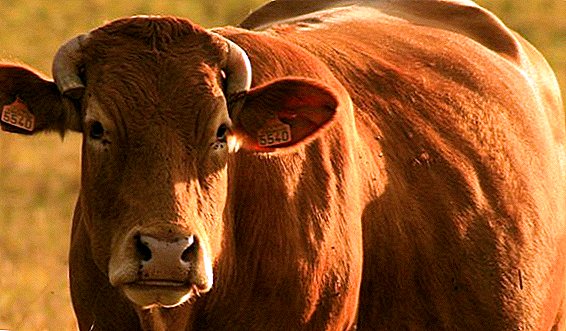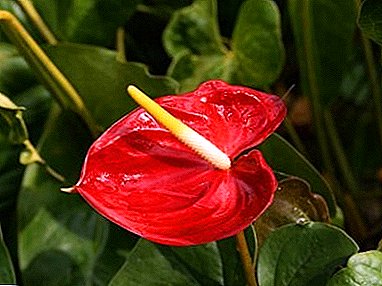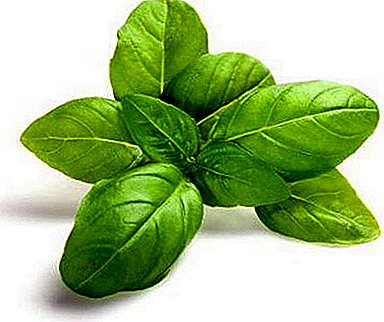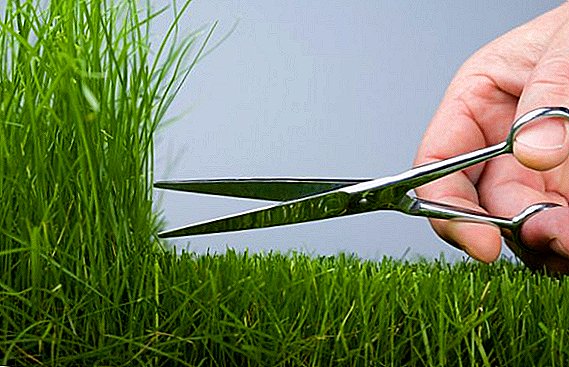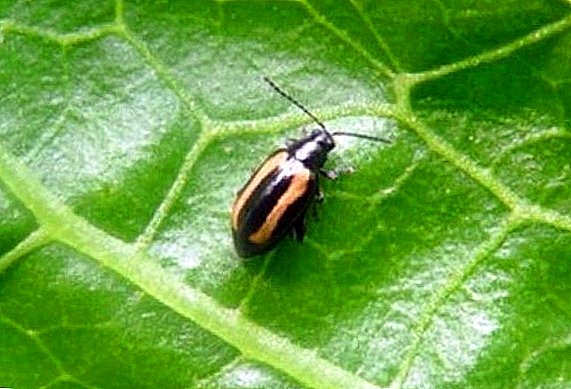 The appearance of cruciferous flea on cabbage is capable of delivering a lot of trouble to both novice gardeners and hardened aces of this occupation, but it is sometimes quite difficult to get rid of it. The following text will be devoted to the struggle with the cruciferous flea, which has settled on your cabbage.
The appearance of cruciferous flea on cabbage is capable of delivering a lot of trouble to both novice gardeners and hardened aces of this occupation, but it is sometimes quite difficult to get rid of it. The following text will be devoted to the struggle with the cruciferous flea, which has settled on your cabbage.
Pest description
Cruciflo flea - pest, which got its name from the culture, which predominantly eats, opting for representatives of both the cultural cruciferous (cabbage, radish, colza) and weed cultures (for example, mustard and shepherd's purse), which is a whole science to fight with.
Did you know? Parasites on cruciferous cultures are not only adult representatives of this species, but also larvae.They are rather small sizes (from 2 to 4 mm), they jump well, have a shiny body. The color scheme may vary depending on the type, from black with a tint to metallic.
 Some species have fairly noticeable stripes on the elytra. The femoral parts of the hind legs are significantly thickened, allowing them to jump well.
Some species have fairly noticeable stripes on the elytra. The femoral parts of the hind legs are significantly thickened, allowing them to jump well.Larvae develop and live underground, feeding on the root system of plants. The period for which the larva turns into an adult is about 2-4 weeks.
At the end of July, the larvae pupate and caterpillars appear 6–14 days later, which then turn into mature individuals.
What is the danger?
The process of awakening of pests begins in springtime, when the average daily air temperature begins to approach + 15 ° С.
Small beetles eat up the peel of young leaves and stems of your cabbage, and their developing larvae grind the roots of plants.  If there are many fleas that attacked your plant, it can die in just a few days. Even if you managed to save your landings from the already started invasion of flea beetles, the crop will lose its pleasant aesthetic appearance.
If there are many fleas that attacked your plant, it can die in just a few days. Even if you managed to save your landings from the already started invasion of flea beetles, the crop will lose its pleasant aesthetic appearance.
In this regard, it is recommended not to wait for the moment when the plants will be attacked by the pest, but immediately after making the landing, take a set of preventive measures, which are described below.  The most dangerous are fleas for young, newly planted plants, since they still have an insufficiently well-formed vegetative mass and with a higher probability will not suffer this “attack”.
The most dangerous are fleas for young, newly planted plants, since they still have an insufficiently well-formed vegetative mass and with a higher probability will not suffer this “attack”.
Signs of cruciferous flea on cabbage
To determine the appearance of cruciferous flea can be on the appearance of plants. First, before the period of emergence of adult individuals, it becomes noticeable that the leaves of the plant wither, even despite its abundant watering. This occurs as a result of the destructive impact of the larvae of the flea on the root.
Did you know? It is still unknown who is a wild relative of the cabbage garden, it is unclear in what place it was first grown as a cultivated plant.
Later, after the appearance of imago, ulcerous gnawing, inter-vein crevices, and even skeletonization of the leaf begin to appear on the leaves of cabbage until the state of the presence of veins alone.
Learn ways to effectively fight against rapeseed flower beetle, ants, flea beetles, cabbage, shchitovki and false guard, leafworm, spider mite, moth.Severe damage to the leaves leads to their drying and further death of the plant.
Methods of struggle
If you are sure that the cruciferous flea has settled on your cabbage, it's time to take measures to combat its complete destruction.  Modern science has developed a wide range of chemicals that can help you in the fight against this pest, but no one forbids you to use folk remedies, many of which show no less effective.
Modern science has developed a wide range of chemicals that can help you in the fight against this pest, but no one forbids you to use folk remedies, many of which show no less effective.
Folk methods
Grandfather's proven methods include the following activities:
- The easiest way to implement - maintaining a stable wet environment. The effectiveness of this method is due to the fact that the flea is not able to survive in a wet environment. That is why radishes, cabbages and other cruciferous plants are recommended to be planted in wet areas of your garden.
- Pollination of leaves with dry powders. Powder is prepared from wood ash and lime-fluff or tobacco dust in a 1: 1 ratio, and then poured into a gauze bag. You should shake this bag over the affected plants in the morning periods, before the dew comes down.
- You can use the same method of dry pollination, but already the land between rows and using naphthalene or tobacco dust.
- Spraying various decoctions and infusions. For example, steaming ash in boiling water in a ratio of 1: 3, after infusing for several days, add a little soap solution or, say, process 200 g of garlic and 1 cup of tomato leaflets using a food processor, then add the mixture to 10 liters of water of average temperature, after straining, add 1 spoon of liquid soap.
- Haveseedling and seedling cover. Suitable for those who have light covering material available (lutrasil, agrospan, spanbond). Cover them with young seedlings, as a result, the midges simply do not crawl to the desired plants, while air, light and water easily overcome this barrier.
- You can also catch flea with pieces of cloth.which are well impregnated with used automotive oil. To do this, these pieces of fabric should be placed on cardboard sheets placed along the beds. For the greatest efficiency, it is recommended to place traps at a distance of 4 m from one another.
Important! If traditional methods do not give the expected effect, do not over-tighten and proceed to chemical treatment, since every day the probability of losing the crop will only increase.
Chemicals
The best result will certainly be given by spraying your plants with insecticide solutions.
However, it should be remembered that most of these drugs are a threat to human health, so you should observe precautions when working with them.  You can use any solution, for example: Aktara, Karbofos, Sherpa, Decis, Arrivo, ECD and many others.
You can use any solution, for example: Aktara, Karbofos, Sherpa, Decis, Arrivo, ECD and many others.
Remember that each of these solutions has individual, different from other methods of preparation and application rates. Therefore, properly read the instructions before processing.
It is best to spray these preparations in the evening, after sunset, because during this period almost all the midges sit on the sheets.
Pest prevention on cabbage
Before you deal with cabbage flax, you can and should try to prevent its occurrence on your site.  The first measure to help prevent the occurrence of a flea is to destroy the cruciferous weeds that feed on this insect in the first period after its awakening after hibernation.
The first measure to help prevent the occurrence of a flea is to destroy the cruciferous weeds that feed on this insect in the first period after its awakening after hibernation.
Important! In the autumn, it is necessary to dig up your plot, because this insect, like many others, chooses the upper layers of soil for wintering, so after digging it turns out to be on the surface, where it quickly dies when frost occurs.
It is very important to take measures to facilitate the early maturation of young plants. - timely and abundant feeding, watering, regularly conducted loosening of the soil.
It is recommended to plant cruciferous crops near phytoncides - plants that produce chemicals, the smell of which drives off annoying insects.
For cruciferous crops include: dill, tomatoes, garlic, potatoes, nasturtium, cumin, coriander, calendula and marigolds.Now you will have no difficulty to overcome the annoying pest.
The main thing to remember is that every day of delay increases the chances that your crop may die, so it is important not to delay the transition from traditional methods of pest control to the use of chemicals.


